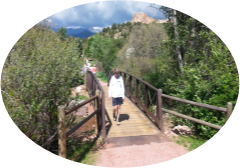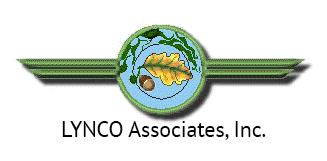Bridges: Transition Points on Our Pathway
The bridge in this photo is taking this person from one section of that park to another. She is leaving specific scenery and activities and moving into another environment. The bridge provides connections and supports for this transition.
Connecting the Old to the New
Learning what we can in one place can lead to a bridge that can provide connections to a new opportunity. The key to utilizing the bridge is to be aware that it is there. Many bridges have wooden slats, some of which can have spaces so you can see what is happening below you. Consider what you could learn be examining all the directions: up, down, left, right. Take the time to consider what is below the bridge. Perhaps it is a stream, or a dry stream bed that deer and cougars use as a trail. Perhaps that stream overflows the banks in the swift summer storms. Some of the storms could actually wash out the bridge, breaking the connection between what was and what will be. Your imagination creates ways to use that bridge as a means for contemplating where you are going.

This is perhaps a meditation. Stand on the bridge and see the connections of the bridge to the land, of the rails to the bridge, of the wooden slat to the rails. How are these a metaphor for the connections and transitions in your life? Going from student to entrepreneur, from single to married, from couples to parents, from sadness to gratitude, from middle to old age. What can you learn from the bridge to connect you from one aspect of life to another?
SUPPORT STRUCTURES
The bridge also provides supporting structure to help you along the way. Without the bridge, you might have to climb down dangerous rocks, or struggle through a tangle of brush and vines that would certainly hinder your progress. The bridge can also be people you meet who provide the supporting structures to help you in your journey. Not every person you meet will have the right support, but every one you meet will create new supports in your mind about what you need and do not need.
Also, in thinking about the supporting structure, it is important to consider what kind of force or pressure it can hold. This is another metaphor. What kind of supporting structure do you have to withstand the force or pressure that you will be entering on the other side of the bridge? For instance, those who enter the military may not know how to parachute out of an airplane, or defuse a bomb, or spend days and nights in clammy, cold, and bug infested areas. The supporting structures for the military begin with “boot camp” where the entire game is focused on emotional, mental, physical, and spiritual fortitude. Following that time, there are specific training experiences that teach recruits to use weapons, communications tools, drones, drive tanks, or fly helicopters, or propel themselves under the ocean. These bridges that create a path for future warriors to be able to do what is necessary to meet a goal and save lives, including their own.
BRIDGES AS METAPHORS
Not all of us will be moving across such challenging bridges. However, each step we take on our path requires commitment, structure, connections, and support systems that a bridge can provide. Study the bridges that you see: the ones that carry trains, the ones that cross over highways, the ones that are made of rope and wood, as well as those made with steel and concrete. Look at the bridges that the animals create: squirrels use slender branches to launch themselves from one tree to the next; monkeys use vines in the forest to move from one place to another; ants create bridges out of leaves and twigs, or each other, to cross over areas; bears and cougars might use the rocks in a stream bed as their bridge.
For most of us humans, the important bridges we need are those in our minds. We need to harness the issues that will propel us to the next landing place, and overcome the fear and the lethargy that prevents us from making the important transitions. The bridges are there, you just need to step out (one step at a time) — kind of like that scene in Indiana Jones, where it looks like there is nothing but open space, but our hero uses his faith in the next step that allows him to cross over the depths below. And sometimes, we transition over the bridges without even realizing it.



